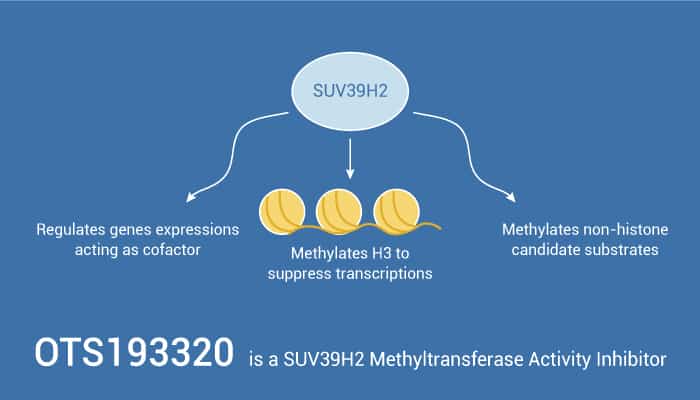SUV39H2 is a histone lysine-specific methyltransferase. Specifically, SUV39H2 introduced H3K9me3 to induce transcriptional inhibition. This plays a key role in heterochromatin maintenance, DNA repair, more recently, carcinogenesis. Besides, the genetic ablation of SUV39H1 and SUV39H2 genes leads to severe chromosome instability. For example, abnormally long telomeres are less bound to chromosomal proteins Cbx1, Cbx3, and Cbx5. SUV39H2 has experienced severe upregulation in tumor tissues. RNA-seq indicates that TPM4, STOM, and OPTN may be affected by the loss of SUV39H2 function. Moreover, SUV39H2 may be a potential oncogene of lung adenocarcinoma, which mediates tumorigenesis and metastasis. SUV39H2 deficiency causes troponin in embryonic brain β The increased expression of the (Pcdhb) cluster factor set was attributed to the deletion of H3K9 trimethylation (me3) at the gene promoter.
Furthermore, SUV39H2 restricts the fate transition by inhibiting H3K9me3 gene promoters that mark the coding components of the Wnt/p63/adhesion axis, thus maintaining the stem cell and progenitor cell pools. In particular, SUV39H2 trimethylated LSD1 on lysine 322. Obviously, SUV39H2-mediated LSD1 methylation inhibits polyubiquitination, leading to the stability of the LSD1 protein. Overexpression of SUV39H2 promotes cell proliferation, which indicates that SUV39H2 may have carcinogenic activity in human osteosarcoma. Exhaustion of SUV39H2 expression leads to an increase in the G1 phase cell population and induces apoptosis. Today, we will introduce a SUV39H2 methyltransferase activity inhibitor, OTS193320.

OTS193320 is a SUV39H2 Methyltransferase Activity Inhibitor.
Firstly, OTS193320 is an imidazo[1,2-a]pyridine compound. Particularly, OTS193320 decreases global histone H3 lysine 9 tri-methylation levels in breast cancer cells and triggers apoptotic cell death. A combination of OTS193320 with Doxorubicin (DOX) results in a reduction of γ-H2AX levels as well as cancer cell viability compared to a single agent OTS193320 or DOX.
Secondly, OTS193320 has a growth inhibitory effect on breast cancer cell lines. OTS193320 exhibits a high inhibitory effect against SUV39H2 enzymatic activity (IC50=22.2 nM). Meanwhile, OTS193320 shows a growth suppressive effect of SUV39H2-positive A549 lung cancer cells (IC50=0.38 μM). Nonetheless, OTS193320 induces apoptosis in breast cancer cells.
Again, OTS193320 causes attenuation of H3K9me3 levels in a dose-dependent manner. Interestingly, OTS193320 sensitizes breast cancer cells to doxorubicin via attenuation of γ-H2AX. A combination of OTS193320 and doxorubicin (DOX) significantly attenuates cancer cell viability in vitro, compared to single agent treatment of either drug.
Finally, OTS193320 is a SUV39H2 methyltransferase activity inhibitor.
References:
Theodore Vougiouklakis, et al. Oncotarget. 2018 Aug 7;9(61):31820-31831.